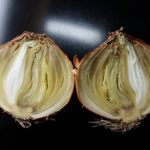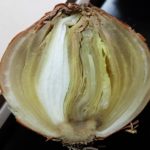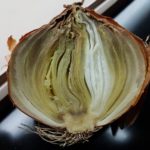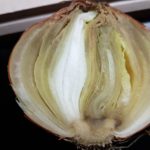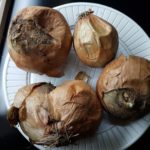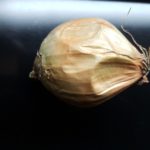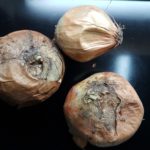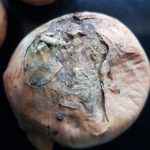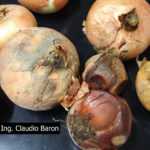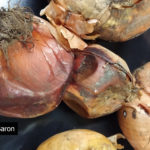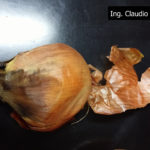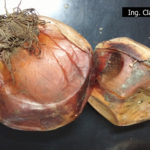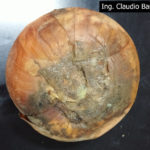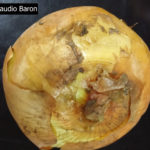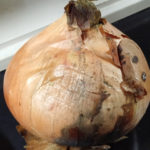.
Grupo de cultivos: Hortícolas
Especie hospedante: Cebolla (Allium cepa)
Etiología: Complejo bacteriano. Bacterias Necrotróficas
Agente causal: Pectobacterium carotovorum, Pseudomonas aureginosa, Enterobacter cloacae
Taxonomía:
Bacteria > Proteobacteria > Gammaproteobacteria > Enterobacterales > Pectobacteriaceae > Pectobacterium
Bacteria > Proteobacteria > Gammaproteobacteria > Pseudomonadales > Pseudomonadaceae > Pseudomonas > Pseudomonas aeruginosa group
Bacteria > Proteobacteria > Gammaproteobacteria > Enterobacterales > Enterobacteriaceae > Enterobacter > Enterobacter cloacae complex
.
.
.
Síntomas
Las catáfilas externas se observan arrugadas y hundidas, los tejidos reblandecidos y se percibe un olor fetido. Cualquier herida producida en el bulbo, o el curado inadecuado del cuello y las catáfilas exteriores, resultan una vía de entrada para las bacterias.
Al inicio del ataque el bulbo se presenta firme al tacto, pareciendo un bulbo sano, sin embargo, al revisar y apretar la zona del cuello se presenta húmedo y surge líquido al apretar esa zona. Se manifiesta preferentemente en postcosecha y es causal de rechazos de exportación.
.
Condiciones predisponenetes
Bajo condiciones elevadas de humedad y temperatura (25 – 30ºC) se intensifica la agresividad del patogeno. Se manifiesta en mayor medida en años «Niño» donde coincidan precipitaciones abundantes, principalmente en el último mes de terminación del cultivo.
.
- 01 Podredumbre blanda bacteriana de la cebolla
- 02 Podredumbre blanda bacteriana de la cebolla
- 03 Podredumbre blanda bacteriana de la cebolla
- 04 Podredumbre blanda bacteriana de la cebolla
- 05 Podredumbre blanda bacteriana de la cebolla
- 06 Podredumbre blanda bacteriana de la cebolla
- 07 Podredumbre blanda bacteriana de la cebolla
- 08 Podredumbre blanda bacteriana de la cebolla
- 09 blanda bacteriana de la cebolla
- 10 Podredumbre blanda bacteriana de la cebolla
- 11 Podredumbre bacteriana de la cebolla
- 12 Podredumbre bacteriana de la cebolla
- 13 Podredumbre bacteriana de la cebolla
- 14 Podredumbre bacteriana de la cebolla
- 15 Podredumbre bacteriana de la cebolla
- 16 Podredumbre bacteriana de la cebolla
- 17 Podredumbre bacteriana de la cebolla
.
Manejo de la enfermedad
* No existe resistencia genética para su control.
* Erradicar plantas enfermas.
* Evitar las heridas al momento de la cosecha o durante las labores culturales.
* Realizar la recoleccion de la cebolla con la menor humedad posible.
* Propiciar un curado adecuado para que el bulbo se selle.
.
.
.
Bibliografía
Abd-Alla MH, Bashandy SR, Ratering S, Schnell S (2011) First report of soft rot of onion bulbs in storage caused by Pseudomonas aeruginosa in Egypt. Journal of Plant Interactions 6(4): 229-238. doi: 10.1080/17429145.2010.535618
Abu-Obeid I, Khlaif H, Salem N (2018) Detection and Identification of Potato Soft Rot Pectobacterium carotovorum Subspecies carotovorum by PCR Analysis of 16S rDNA in Jordan. Agricultural Sciences 9: 546-556. doi: 10.4236/as.2018.95037
Akramipour N, Abdollahi M, Taghavi SM, Rezaei R (2017) Genetic diversity of soft rot strains of Pectobacterium, isolated from different hosts, using ISSR marker. Archives of Phytopathology and Plant Protection 50: 789-801. doi: 10.1080/03235408.2017.1384195
Palacio‐Bielsa A, Cambra MA, López MM (2007) First report of bacterial soft rot on onion caused by Dickeya sp. (ex Pectobacterium chrysanthemi) in Spain. Plant Pathology 56: 722-722. doi: 10.1111/j.1365-3059.2007.01589.x
Tovar-Herrera OE, Rodríguez M, Olarte-Lozano M, et al. (2018) Analysis of the Binding of Expansin Exl1, from Pectobacterium carotovorum, to Plant Xylem and Comparison to EXLX1 from Bacillus subtilis. ACS Omega3(6): 7008–7018. doi: 10.1021/acsomega.8b00406
, , , et al. (2020) A PCR diagnostic assay for rapid detection of plant pathogenic pseudomonads. Plant Pathology 69: 1311– 1330. doi: 10.1111/ppa.13204
, , , et al. (2020) Pectobacterium atrosepticum KDPG aldolase, Eda, participates in the Entner–Doudoroff pathway and independently inhibits expression of virulence determinants. Molecular Plant Pathology 00: 1– 13. https://doi.org/10.1111/mpp.13025
Yurgel SN, Abbey L, Loomer N, Gillis-Madden R, Mammoliti M (2018) Microbial Communities Associated with Storage Onion. Phytobiomes 2(1): 35-41. doi: 10.1094/PBIOMES-12-17-0052-R
